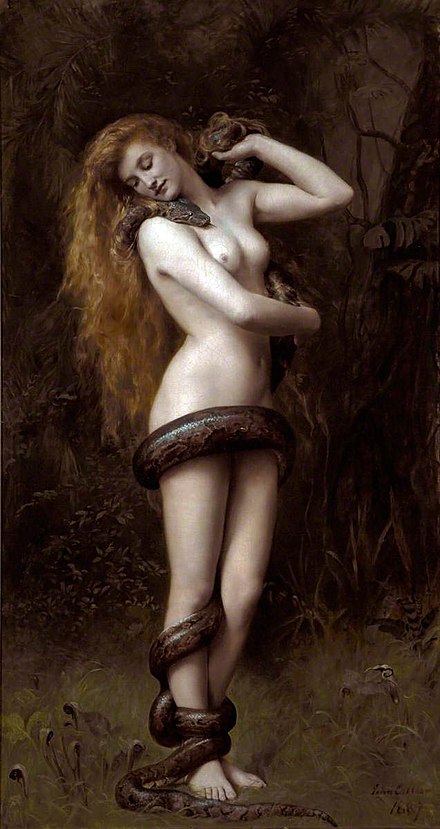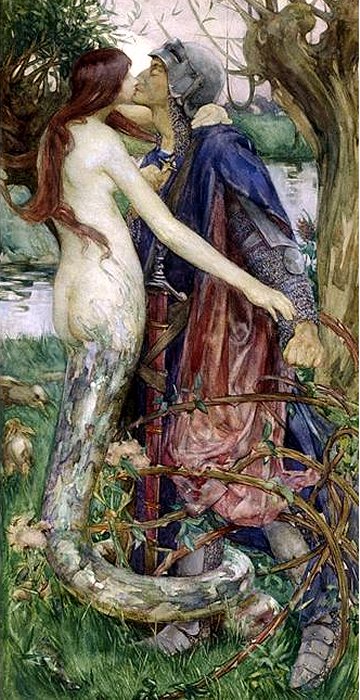 Meet the Ancestors (sort of)...
Meet the Ancestors (sort of)...
So to return to the question I asked at the beginning, and never answered, who or what was the first vampire? I didn’t answer because it’s pretty hard to say. Where does the line between blood-drinking demons or evil spirits and actual vampires lie? Are they both the same? Is one the progenitor of the other? We can look to the Bible, or further, as much of what is in that Holy Book is based on earlier legend anyway, and there we find one of the candidates for the first vampire, who is, rather ironically, a woman.
 Lilith, or Lilitu
Lilith, or Lilitu
Perhaps marking one of the first, but enduring, beliefs that women cause all the trouble (thank you, Book of Genesis!) Lilith crops up in Hebrew belief as the first wife of Adam, but is originally based on figures from ancient Assyrian and Babylonian myth, where she is known as Lilitu, which means night hag, night demon, night monster etc. Unlike the Christian Eve, who is said to have been created from one of Adam’s ribs, Lilith is depicted as having been made from the same clay as him, so technically while Eve would be seen, from the moment of her creation, as a part of and therefore inferior to Adam, Lilith can be seen to be all but equal to him. Nevertheless, according to Hebrew scripture, having refused to be subservient to Adam she ran off and got it on with an angel, said to be Sammael, the Jewish figure of Satan himself, afterwards refusing to return to the Garden of Eden.
Although it’s hard to confirm, with such ancient religions leaving behind few written accounts and ideas and opinions changing as time continues its inexorable march, Lilith in Sumerian belief seems to have been a demon who flew around the underworld bringing nightmares, and is seen as a hateful figure who can, something like a succubus, transform herself into the likeness of a man’s wife and conceive a child with him. Later, Lilith would seek revenge upon the true children of the man and woman, making her a thing to be feared by children and parents alike. This legend would survive into Hebrew times, where the words “lilith-abi” would be inscribed on four amulets hung in a child’s bedroom by Jewish mothers, meaning “Lilith - begone!” and give us our present-day word lullaby.
From the stories told about her, it’s probably fair to demote, or promote, Lilith to the level of a witch - perhaps the first witch - rather than a vampire, but she is said to have drank the blood of infants and to have stirred the desire of men, whereas the vampire, particularly the romantic variation, certainly directed his sexual power at women, or occasionally, if female, at men. There are instances of homosexual or at least bisexual vampires in the writings of Rice and Lee, but they don’t seem to be based on any legend and are surely just there for the advancement of their stories and the development of their characters.
 Lamia
Lamia
Essentially another incarnation of Lilith, Lamia was changed into a bestial being by the Greek goddess Hera after all her children had been destroyed by Zeus’s wife (or she had compelled Lamia to do so herself) in retaliation for Lamia sleeping with her husband. Alternatively, she was a Libyan queen who ordered infants snatched, Herod-like, from their mothers and killed, her savagery affecting her appearance and turning her into a monster. More horribly, the Greek philosopher Aristotle spoke of a ravening beast which tore open the bellies of pregnant mothers and devoured the fetuses. Lamia is the first of these beings to be given shape-shifting abilities, something that would become attached to the vampire myth.
Because of the above, the Lamia became a name used to frighten children into good behaviour, a kind of ancient bogeyman, and she began to be depicted as half-woman, half-serpent. This possibly removes her from the running for being a true vampire, but there are references to her and her kind sucking and drinking blood as well as seducing sleeping men, so some aspects are definitely there. Intelligence and gentility, however, attributes given to the modern vampire, are not: Lamia and her fellow creatures are said to be stupid, and to stink.
A similar creature, called the empousa, was known to target young men for the quality and purity of their blood, and would fatten up her victims before killing and devouring them. This is not necessarily something that translated to the later vampire myths, though Dracula is seen encouraging Jonathan Harker to eat at his castle, while he, the Count, partakes of no food, and it is later revealed that there are three hungry female acolyte vampires in the cellars or dungeon of the castle who wish to feed on him. Other features of the empousa, such as having a foot made of bronze or cow dung, and being frightened away by loud noises, certainly do not conform to our stereotype of the vampire.
Strix
Perhaps leading to the involvement of the vampire bat in the legend, the strix was a bird of antiquity said to feed on the blood and flesh of humans. Description of it as a “nocturnally crying creature which positioned its feet upwards and head below” lends more weight to this possibility. The strix is the first case where we hear of the efficacy of garlic against the beast, which might help explain why it’s seen as being useful in warding off vampires. Strix were also said to be the transformed Polyphontes, in retribution by the gods of she and her sons’ cannibalistic tendencies (this also explaining why these strange birds craved human flesh and blood). Striges (plural of strix) have been called “vampire owls”, which certainly fits the description of their behaviour. Later, it was believed that striges transformed into witches, and vice versa, lending more credence to the myth of their association with vampires and creatures of darkness.
Vetala
Really more a precursor to the Haiitian zombie, the vetala comes from Indian legend, where it would inhabit the corpse of a recently-buried person and reanimate it, though it does not seem to have been to any evil end, more for mischief. Additionally, vetala are not said to have drank blood, though they did hang upside-down like bats.
Shtriga and dhampir
Dhampir sounds very close, doesn’t it? But let’s deal with shtriga first. Basically witches in Albanian folklore, they were said to possess the evil eye and could curse people, being the only ones who could lift the curse. It was feared they sucked the blood of infants at night, and transformed into flying insects once they had had their fill. One explanation offered for their being evil is that they were childless women, who were jealous of the offspring of others. Again, garlic was used to ward against them or banish them. The crucifix and holy water comes in here too, perhaps for the first time, though as usual it’s the Catholic Church trying to assert its power over the pagan monsters.
Despite what I said about the name though, dhampirs can’t be considered as forebears of the vampire, as they appear to be the result of a union between a vampire and a human. In fact, Slavic tradition has it that dhampirs could see vampires who were invisible to other eyes, and this led to many of them pursuing a career as vampire hunters. Dhampirs were supposed to have no shadow - a handy attribute if you are a vampire hunter - and no bones (not quite so handy), making them seem “slippery and jelly-like”. Uh-huh. Some of the more famous fictional dhampirs are Blade, Connor from the series
Angel and Rayne from the movie
Bloodrayne.
Moroi and Strigoi
One of almost the birthplaces of the vampire, at least the romantic, novellised one, is Romania, and Stoker set his seminal novel near here, in the Carpathian Mountains. Not too surprising, when you hear the tales and beliefs that emanated from that area. Moroi were basically ghosts which left the grave to trouble the living, while strigoi were witches with two hearts and two souls, which could send out their spirits at night to meet up with others of their kind and attack and consume the blood of animals and humans. After death, strigoi would roam the night, attacking their living family, drinking their blood. Interestingly, in Romanian folklore there were several ways people could become vampires, and some were born fated to be nightcrawlers. A living strigoi would, when she passed away, become a revenant, a dead (or undead) strigoi, but any unbaptised child, anyone who was born with a caul, an extra nipple, a tail or extra hair was also doomed to become a vampire.
If you happened to be the seventh boy or seventh girl in a family of all the same sex, that was it for you: vampire in the making. Similarly, if your mother had the bad luck to have a black cat cross her path, if you were born too early, out of wedlock or had blue eyes and red hair your fate was sealed. A pregnant woman who didn’t eat salt, or one considered a strigoi was liable to give birth to a vampire, and anyone who died an unnatural death was also at risk.